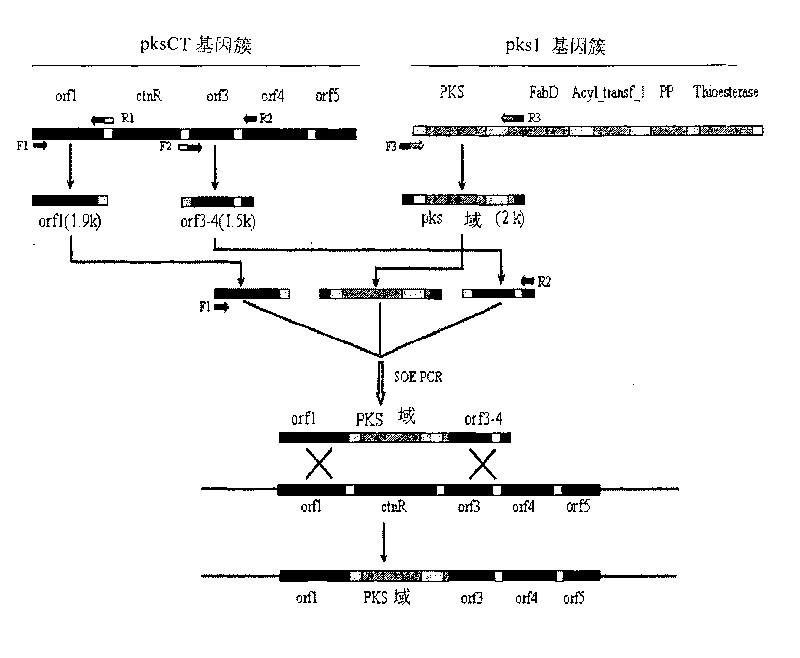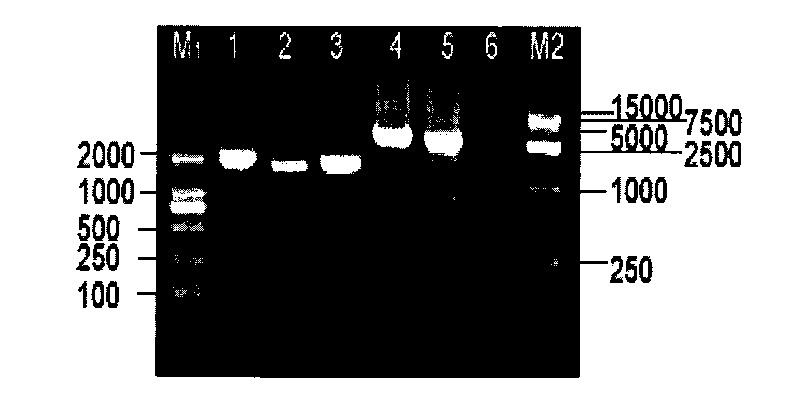Recombined monascus purpureus with characteristics of low citrinin expression and high haematochrome expression
A technology of monascus and citrinin, applied in the field of microorganisms, can solve problems such as food safety and ecological safety concerns, affecting synthesis, etc.
- Summary
- Abstract
- Description
- Claims
- Application Information
AI Technical Summary
Problems solved by technology
Method used
Image
Examples
Embodiment 1
[0022] Knockout of embodiment one Monascus ctnR gene
[0023] 1. Monascus Genomic DNA Preparation
[0024] The common Monascus strain TY0701 used in the fermentation industry was used as the starting Monascus strain, which was preserved in the inventor's laboratory.
[0025] The Monascus genomic DNA was prepared by the following steps: 1) Scrape off the mycelium from the PDA plate cultivated for 10 days, dry it with filter paper, and weigh 200 mg. 2) Wrap the weighed mycelium in tin foil and freeze it in liquid nitrogen for 10 minutes; 3) Take 1ml CTAB (2×) and add 20 μl of β-mercaptoethanol (final concentration 2%) in a fume hood, and set aside in a 65°C water bath ;4) Put the mortar pre-frozen at -20°C on ice, dry it, add a small amount of quartz sand, and then add liquid nitrogen twice to pre-cool the mortar; 5) Add the frozen mycelium to the mortar , grind into powder, about 10min; 6) Transfer the ground powder to a 1.5ml EP tube, add CTAB preheated at 65°C, gently pipet...
Embodiment 2
[0043] Example 2 Screening and detection of recombinants with low citrinin content
[0044] 1. Preparation of Monascus protoplasts
[0045] 1) Elute the mycelium with a bacterial age of 40-50h on the cellophane, soak it in 5mmol DTT solution for 20-30min; wash it with sterile water, dry it with sterile filter paper, and transfer it to a sterile Erlenmeyer flask;
[0046] 2) Add a certain amount (10ml for every three dishes of mycelium) to the Erlenmeyer flask with 1M MgSO 4 The solution is an enzymolysis solution prepared by a solvent (helicase: lysozyme: cellulase=0.6%: 0.4%: 0.8%) and a small amount of sterilized quartz sand; under sterile conditions, 30°C, 100rpm, enzymolysis;
[0047] 3) Filtrate, centrifuge the filtrate at 3,200rpm for 10min; discard the supernatant, and resuspend the precipitate with pre-cooled 1M MgSO4 solution;
[0048] 4) Repeat 3), and equally divide into two small tubes of equal volume.
[0049] 5) Repeat step 3) for two small tubes of the same v...
Embodiment 3
[0061] Pigment and citrinin detection of embodiment three Monascus recombinant ZD19 fermented mycelia
[0062] Monascus recombinant ZD19 slant strain inoculates liquid rice flour medium (rice flour 6%, soybean flour 3%, NaNO 3 0.3%, KH 2 PO 4 0.3%, MgSO 4 ·7H 2 O 0.3%, adjust the initial pH value of the fermentation broth to 3), cultivate at 30°C and 150rpm for 7 days, extract citrinin and analyze the content of citrinin by high performance liquid chromatography. By HPLC analysis, it can be seen that the peak time of citrinin benchmark is 18.195min, the citrinin content of the starting strain fermentation liquid is 0.56 μg / ml, and the citrinin content of the recombinant fermented liquid is 0.25 μg / ml; A drop of 55%. The measurement results are shown in Table 1.
[0063] Table 1: Comparison of Citrinin and Red Pigment Produced by Fermentation of Starting Strain and Recombinant Strain ZD19
[0064] strain
[0065] Results: The citrinin produced by the recombin...
PUM
 Login to View More
Login to View More Abstract
Description
Claims
Application Information
 Login to View More
Login to View More - R&D
- Intellectual Property
- Life Sciences
- Materials
- Tech Scout
- Unparalleled Data Quality
- Higher Quality Content
- 60% Fewer Hallucinations
Browse by: Latest US Patents, China's latest patents, Technical Efficacy Thesaurus, Application Domain, Technology Topic, Popular Technical Reports.
© 2025 PatSnap. All rights reserved.Legal|Privacy policy|Modern Slavery Act Transparency Statement|Sitemap|About US| Contact US: help@patsnap.com



